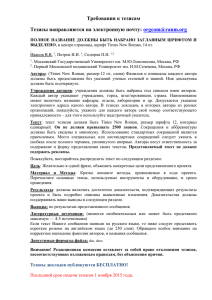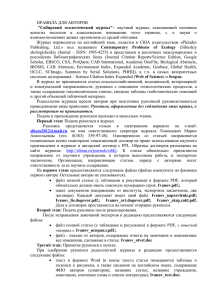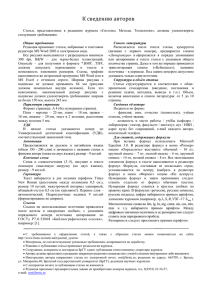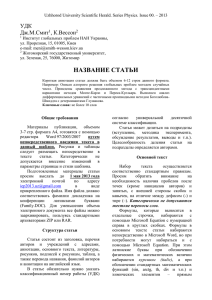правила для авторов - Лимнологический институт Сибирского
advertisement
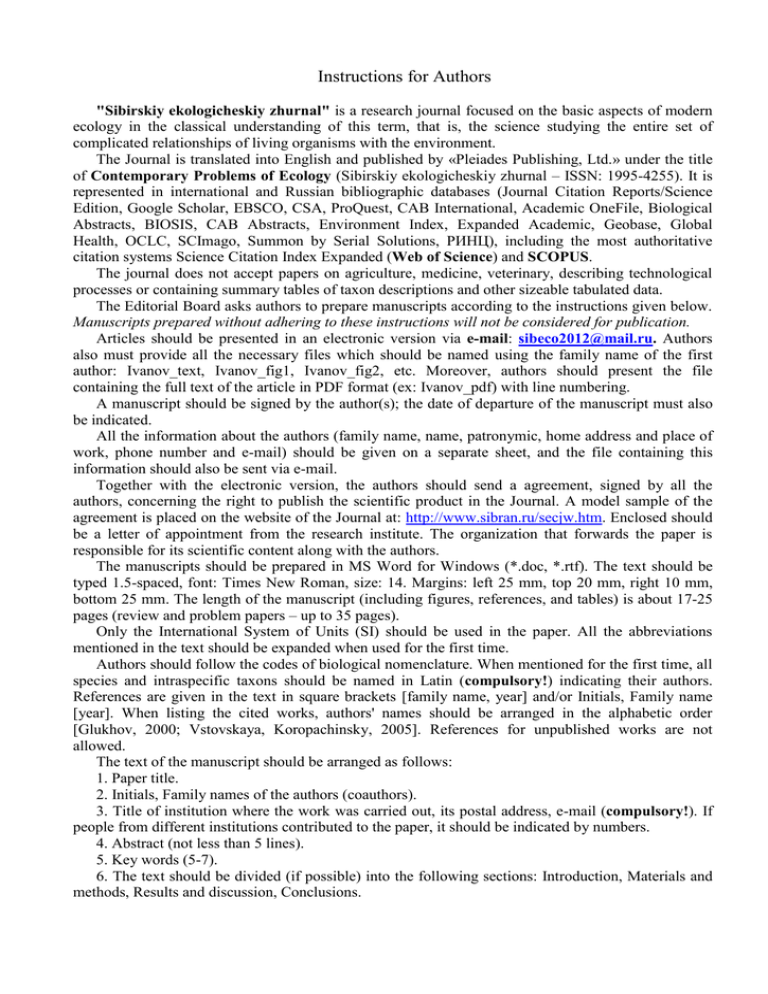
Instructions for Authors "Sibirskiy ekologicheskiy zhurnal" is a research journal focused on the basic aspects of modern ecology in the classical understanding of this term, that is, the science studying the entire set of complicated relationships of living organisms with the environment. The Journal is translated into English and published by «Pleiades Publishing, Ltd.» under the title of Contemporary Problems of Ecology (Sibirskiy ekologicheskiy zhurnal – ISSN: 1995-4255). It is represented in international and Russian bibliographic databases (Journal Citation Reports/Science Edition, Google Scholar, EBSCO, CSA, ProQuest, CAB International, Academic OneFile, Biological Abstracts, BIOSIS, CAB Abstracts, Environment Index, Expanded Academic, Geobase, Global Health, OCLC, SCImago, Summon by Serial Solutions, РИНЦ), including the most authoritative citation systems Science Citation Index Expanded (Web of Science) and SCOPUS. The journal does not accept papers on agriculture, medicine, veterinary, describing technological processes or containing summary tables of taxon descriptions and other sizeable tabulated data. The Editorial Board asks authors to prepare manuscripts according to the instructions given below. Manuscripts prepared without adhering to these instructions will not be considered for publication. Articles should be presented in an electronic version via e-mail: sibeco2012@mail.ru. Authors also must provide all the necessary files which should be named using the family name of the first author: Ivanov_text, Ivanov_fig1, Ivanov_fig2, etc. Moreover, authors should present the file containing the full text of the article in PDF format (ex: Ivanov_pdf) with line numbering. A manuscript should be signed by the author(s); the date of departure of the manuscript must also be indicated. All the information about the authors (family name, name, patronymic, home address and place of work, phone number and e-mail) should be given on a separate sheet, and the file containing this information should also be sent via e-mail. Together with the electronic version, the authors should send a agreement, signed by all the authors, concerning the right to publish the scientific product in the Journal. A model sample of the agreement is placed on the website of the Journal at: http://www.sibran.ru/secjw.htm. Enclosed should be a letter of appointment from the research institute. The organization that forwards the paper is responsible for its scientific content along with the authors. The manuscripts should be prepared in MS Word for Windows (*.doc, *.rtf). The text should be typed 1.5-spaced, font: Times New Roman, size: 14. Margins: left 25 mm, top 20 mm, right 10 mm, bottom 25 mm. The length of the manuscript (including figures, references, and tables) is about 17-25 pages (review and problem papers – up to 35 pages). Only the International System of Units (SI) should be used in the paper. All the abbreviations mentioned in the text should be expanded when used for the first time. Authors should follow the codes of biological nomenclature. When mentioned for the first time, all species and intraspecific taxons should be named in Latin (compulsory!) indicating their authors. References are given in the text in square brackets [family name, year] and/or Initials, Family name [year]. When listing the cited works, authors' names should be arranged in the alphabetic order [Glukhov, 2000; Vstovskaya, Koropachinsky, 2005]. References for unpublished works are not allowed. The text of the manuscript should be arranged as follows: 1. Paper title. 2. Initials, Family names of the authors (coauthors). 3. Title of institution where the work was carried out, its postal address, e-mail (compulsory!). If people from different institutions contributed to the paper, it should be indicated by numbers. 4. Abstract (not less than 5 lines). 5. Key words (5-7). 6. The text should be divided (if possible) into the following sections: Introduction, Materials and methods, Results and discussion, Conclusions. 7. The list of references should contain the cited works, arranged in the alphabetic order. The length of the list of reference for an original article is from 5 to 25 works: for a scientific review – not more than 40 works. Example of the style of Reference list: Adorno T. V. About the logics of social sciences. // Voprosy Filosofii. 1992. No. 10. P. 76-86 (in Russian). Vstovskaya T. N., Koropachinsky I. Yu. Woody plants of the Central Siberian Botanical Garden. Novosibirsk: SB RAS Publishing House, «Geo» affiliation, 2005. 235 p. Glukhov V. A. Investigation, Development and construction of the system of electronic delivery of documents in the library: Abstract of Thesis for Cand degree in Technology. Novosibirsk, 2000. 18 p. Philosophy of culture: interinstitutional collection of scientific works / Saratov State University / ed. by S. F. Martynovich. Saratov, Publishing House of the Saratov State University, 1999. 199 p. Crawford P. J., Barrett T. P. The reference librarian and the business professor: a strategic alliance that works // Reference Librarian. 1997. Vol. 3, N 58. P. 75-85. All illustrations should be submitted in electronically. Vector graphics should be prepared in CorelDRAW (*cdr, *cmx, *wmf), Excel; photographs should be made in Adobe Photoshop (*tif, *bmp, *pcx) with the resolution not less than 400 dpi. Legends that encumber the figure should be replaced with digital or letter symbols that are explained in Figure Captions. The axes of plots should be accompanied by the titles depicting their meaning. The size of letters and numbers in the figures should be proportional to the size of figures, so that they could remain readable after reduction. The size of a figure should not exceed the size of a printed page. Figure captions are listed on a separate page at the end of the paper. Figures are published in black and white. In particular cases figures can be published in colour at extra charge. Reviewing procedure is closed. Copies of reviewers' comments are sent to authors; original comments are kept in the Editorial Board of the Journal. If reviewers point out the necessity to revise the paper, it is sent to the authors for revision. In this case, the date of submission of the revised version is considered as the submission date. The paper sent to the author for revision should be returned together with the initial version as soon as possible. A paper not returned by the authors for more than 1 months is automatically removed from consideration. A letter from the authors containing responses to reviewers' comments and explanations of all the changes made in the paper should be enclosed with the revised version. The final decision concerning the possibility of publication is made by the Editorial Board of the Journal. The editors hold the right to edit the manuscript without wrenching its sense. The final text is reconciled with the authors when the proofs are sent to the authors for approvement. The following files should be provided to the editors: - - The text of the article (tables and figure captions should be placed in the end of it), e.g. Ivanov_text.doc Figures (every figure is sent in a separate file of the required format: vector graphics should be prepared in CorelDRAW (*cdr, *cmx, *wmf), Excel; photographs should be made in Adobe Photoshop (*tif, *bmp, *pcx) with the resolution not less than 400 dpi.), e.g. Ivanov_fig1, Ivanov_fig2 The full text of the article in PDF format with line numbering (compulsory!), e.g. Ivanov_pdf Information about the authors If after reviewing the article is corrected, all the files except information about the authors and the list of scientific terms should be labeled with the word “corrected” and once again sent to the editors. Example of an article: Redistribution of Vegetation Zones and Populations of Larix sibirica Ledeb. and Pinus sylvestris L. in Central Siberia in a Warming Climate N. M. TCHEBAKOVA 1, G. REHFELDT 2, E. I. PARFENOVA 1 1 2 V. N. Sukachev Institute of Forest SB RAS 660036, Krasnoyarsk, Akademgorodok, chebacova@mail.ru Mountain Forest Station U.S. Forest Service 1221, Main Street., Idaho, 83843, USA Changes in areal coverage of vegetation zones across Central Siberia and of Larix sibirica Ledeb. and Pinus sylvestris L. climatypes in southern Krasnoyarsk Territory and Tuva in a warming climate were estimated from bioclimatic models connecting the characteristics of vegetation with climate. Predictions by the models for the end of the century suggest a complete redistribution of both vegetation zones over plains and tablelands of Siberia, and climatypes of pine and larch over southern mountains and foothills. Northern vegetation types -tundra, forest-tundra and northern taiga, which are dominant in current climate, will be replaced by southern types such as the southern taiga and subtaiga, as well as forest-steppe and steppe, both of which do not currently exist north of 56° N. Dark-needled taiga will move eastwards following the retreat of permafrost. Key words: Larix sibirica, Pinus sylvestris, climate, bioclimatic models, Middle Siberia. (Text of the article) … … REFERENCES Adorno T. V. About the logics of social sciences. // Voprosy Filosofii. 1992. No. 10. P. 76-86 (in Russian). Vstovskaya T. N., Koropachinsky I. Yu. Woody plants of the Central Siberian Botanical Garden. Novosibirsk: SB RAS Publishing House, «Geo» affiliation, 2005. 235 p. Glukhov V. A. Investigation, Development and construction of the system of electronic delivery of documents in the library: Abstract of Thesis for Cand degree in Technology. Novosibirsk, 2000. 18 p. Philosophy of culture: interinstitutional collection of scientific works / Saratov State University / ed. by S. F. Martynovich. Saratov, Publishing House of the Saratov State University, 1999. 199 p. Crawford P. J., Barrett T. P. The reference librarian and the business professor: a strategic alliance that works // Reference Librarian. 1997. Vol. 3, N 58. P. 75-85. Table 1 Name of the table Table 2 Name of the table Figure captions Fig.1. Name of the figure Fig.2. Name of the figure Fig.3. Name of the figure Date Author’s (coauthors’) signature (on the manuscript) ПРАВИЛА ДЛЯ АВТОРОВ "Сибирский экологический журнал"– научный журнал, освещающий основные аспекты экологии в классическом понимании этого термина, т. е. науки о взаимоотношениях живых организмов со средой обитания. Журнал переводится на английский язык, издается в США издательством «Pleiades Publishing, Ltd.» под названием Contemporary Problems of Ecology (Sibirskiy ekologicheskiy zhurnal – ISSN: 1995-4255) и представлен в различных международных и российских библиографических базах (Journal Citation Reports/Science Edition, Google Scholar, EBSCO, CSA, ProQuest, CAB International, Academic OneFile, Biological Abstracts, BIOSIS, CAB Abstracts, Environment Index, Expanded Academic, Geobase, Global Health, OCLC, SCImago, Summon by Serial Solutions, РИНЦ), в т.ч. в самых авторитетных системах цитирования – Science Citation Index Expanded (Web of Science) и SCOPUS. В журнал не принимаются статьи сельскохозяйственной, медицинской, ветеринарной направленности, рукописи с описанием технологических процессов, а также содержащие таксономические списки и другой объемный табличный материал. Редколлегия журнала просит авторов при подготовке рукописей руководствоваться приведенными ниже правилами. Рукописи, оформленные без соблюдения этих правил, к рассмотрению не принимаются. Статьи представляются в печатном (1 экз.) и (обязательно!) электронном вариантах по email: sibeco2012@mail.ru. При этом необходимо представить все требуемые файлы, которые именуются по фамилии первого автора: Ivanov_text, Ivanov_fig1, Ivanov_fig2, и т.д. Также представляется файл полной статьи в формате PDF: Ivanov_pdf, который обязательно должен иметь сквозную нумерацию строк. Рукопись подписывается автором (авторами) с указанием даты отправления. Сведения об авторах, включающие фамилии, имени, отчества (полностью), домашний адрес, место работы, телефон и e-mail приводятся на отдельном листе, а также высылаются по электронной почте отдельным файлом. Кроме того, требуется предоставить на английском языке: сведения, содержащие ФИО авторов (соавторов), название статьи, название учреждения, аннотацию, ключевые слова и список литературы; перечень терминов, использованных в статье (отдельным файлом). Рукописи статей на бумажном носителе следует высылать только простым письмом по адресу: 630090, г. Новосибирск, ул. Золотодолинская, 101, ответственному секретарю журнала Томошевич Марии Анатольевне (тел. +7 (383) 339-97-48). Одновременно со статьей направляются подписанные всеми соавторами лицензионный договор на право использования научного произведения в журнале и авторский договор с PPL. Образцы договоров размещены на сайте журнала: http://sibran.ru/journals/sibEj. К статье обязательно прилагаются направление от научного учреждения, в котором выполнена работа, и экспертное заключение. Организация, направляющая статью, наряду с авторами несет ответственность за ее научное содержание. Рукописи оформляются в редакторе MS Word for Windows (*.doc, *.rtf). Текст набирается через 1,5 интервала, шрифт – Times New Roman, кегль – 14. Поля страниц: левое - 25 мм, верхнее - 20, правое - 10, нижнее - 25 мм. Ориентировочный объем рукописи, включая рисунки, таблицы и список литературы, должен составлять 17-25 страниц (обзорные статьи – до 35). В статье необходимо использовать только Международную систему единиц СИ. Все аббревиатуры, приводимые в тексте, следует расшифровать при их первом упоминании. Авторы должны придерживаться кодексов биологической номенклатуры. При первом упоминании виды, внутривидовые таксоны приводятся обязательно на латыни с указанием авторов. Названия таксонов выделяются курсивом. Ссылки на литературу в тексте приводятся в скобках [фамилия, год] и/или И.О. Фамилия [год]. При перечислении работ авторы располагаются в хронологическом порядке – [Глухов, 2000; Встовская, Коропачинский, 2005]. Фамилии иностранных авторов приводятся на английском языке – [Motoyama, 1965]. Ссылки на неопубликованные работы не допускаются. При ссылках на статьи, опубликованные в «Сибирском экологическом журнале», следует обязательно упоминать и их английский вариант из «Contemporary Problems of Ecology»: Осипов С.В. Динамика растительного покрова таёжных и гольцовых ландшафтов в верховьях реки Бурея // Сиб. экол. журн. 2012 в. № 3. С. 325–335. [Osipov S.V. 2012. Vegetation Dynamics of Taiga and Alpine Landscapes in the Upper Part of the Bureya River Basin // Contemporary Problems of Ecology. Vol. 5. N 3. P. 235–243.] Текст должен быть оформлен следующим образом: 1. УДК (определяется автором по таблицам Универсальной десятичной классификации). 2. Название статьи. 3. Инициалы, фамилия автора (соавторов). 4. Название учреждения, где выполнялась работа, его почтовый адрес, e-mail (обязательно!) (ecли в paбoтe учacтвoвaли aвтopы из paзныx учpeждeний, этo дoлжнo быть oтмeчeнo цифрами). 5. Аннотация (от 5 до 15 строк). 6. Ключевые слова (5-7). 7. Текст должен иметь (по возможности) следующие разделы: «Введение», «Материалы и методы», «Результаты и их обсуждение», «Выводы» или «Заключение». 8. Список литературы должен содержать цитированные в тексте работы, расположенные в алфавитном порядке. Сначала приводится перечень работ на русском и других языках, использующих кириллицу, а затем работы на языках с латинским алфавитом. Список литературы для оригинальной статьи - не менее 15 и не более 30 источников. Для научного обзора - не более 40 источников. Пример оформления списка литературы: Адорно Т. В. К логике социальных наук // Вопросы философии. 1992. №10. С. 76-86. Встовская Т. Н., Коропачинский И. Ю. Древесные растения Центрального сибирского ботанического сада. Новосибирск: Изд – во СО РАН, филиал «Гео», 2005. 235 с. Глухов В. А. Исследование, разработка и построение системы электронной доставки документов в библиотеке: автореф. дис. … канд. техн. наук. Новосибирск, 2000. 18 с. Осипов С.В. Динамика растительного покрова таёжных и гольцовых ландшафтов в верховьях реки Бурея // Сиб. экол. журн. 2012 в. № 3. С. 325–335. [Osipov S.V. 2012. Vegetation Dynamics of Taiga and Alpine Landscapes in the Upper Part of the Bureya River Basin // Contemporary Problems of Ecology. Vol. 5. N 3. P. 235–243.] Философия культуры: межвуз. сб. науч. тр. / Сарат. гос. ун-т / под ред. С. Ф. Мартыновича. Саратов: Изд-во Саратовского ун-та, 1999. 199 с. Crawford P. J., Barrett T. P. The reference librarian and the business professor: a strategic alliance that works // Reference Librarian. 1997. Vol. 3, N 58. P. 75-85. Иллюстрации предоставляются в печатном и электронном виде, фотографии - на матовой бумаге. На обороте рисунков указываются фамилия автора, название статьи, порядковый номер рисунка. Векторные рисунки должны быть выполнены в программах CorelDRAW (*cdr, *cmx, *wmf), Excel; фотографии – в программе Adobe Photoshop (*tif, *bmp, *pcx), разрешение не менее 400 dpi. Надписи, загромождающие рисунок, должны быть заменены цифровыми или буквенными обозначениями, которые обязательно поясняются в подрисуночных подписях. Оси графиков необходимо сопровождать отражающими их суть надписями. Размеры букв и цифр на рисунках должны быть пропорциональны размеру рисунка, чтобы при уменьшении они были разборчивы. Рисунок по размеру не должен превышать печатной полосы. Подписи к рисункам приводятся в конце статьи. Публикация рисунков осуществляется в черно-белом варианте. В отдельных случаях возможна публикация в цвете за отдельную плату. Рецензирование статей закрытое. Авторам высылаются копии рецензий, оригиналы хранятся в редколлегии журнала. Если в рецензии имеется указание на необходимость исправления статьи, то она направляется автору на доработку. Статья, направленная автору на доработку, должна быть возвращена в максимально короткие сроки. Статья автоматически снимается с рассмотрения, если она не возвращается автором более 3 месяцев. К переработанной рукописи необходимо приложить письмо от авторов, содержащее ответы на замечания и поясняющее все изменения, сделанные в статье. Окончательное решение о возможности ее опубликования принимает редколлегия журнала. Редакция имеет право внесения редакторских изменений в рукопись, не искажающих её смысла. Итоговый текст согласовывается с автором при ознакомлении с корректурой статьи, в которую не предполагается существенных изменений текста. Высланные в редакцию материалы рукописи авторам не возвращаются. В редакцию представляются файлы: текст (в конце текста статьи помещаются таблицы и подписи к рисункам), Ivanov_text.doc; рисунки (каждый рисунок имеет отдельный файл и представляется только в требуемых форматах: Векторные рисунки в программах CorelDRAW (*cdr, *cmx, *wmf), Excel; фотографии – в программе Adobe Photoshop (*tif, *bmp, *pcx), разрешение не менее 400 dpi). Название файлов: Ivanov_fig1, Ivanov_fig2 ; файл полной статьи (с таблицами и рисунками) в формате PDF, который обязательно должен иметь сквозную нумерацию строк. Ivanov_pdf.; сведения об авторах; перечень терминов, использованных в статье, на английском языке; пакет документов (направление от института, экспертное заключение, два договора). Если после рецензирования в статью вносятся исправления, то в редакцию предоставляются вновь все файлы статьи с пометкой «исправл.» (без сведений об авторах и перечня терминов). Пример оформления статьи УДК 630*11:630*165:551.8(571.51) Перераспределение растительных зон и популяций лиственницы сибирской и сосны обыкновенной в Средней Сибири при потеплении климата Н. М. ЧЕБАКОВА1, ДЖ. РЕЙФЕЛЬДТ2, Е. И. ПАРФЕНОВА1 1 2 Институт леса им. В. Н. Сукачева СО РАН 660036 Красноярск, Академгородок chebacova@mail.ru Горная лесная станция Лесной Службы США 1221, Главная ул., штат Айдахо, 83843, США АННОТАЦИЯ На основе биоклиматических моделей, связывающих характеристики растительности с климатом, рассчитаны изменения площадей растительных зон в пределах Средней Сибири и популяций Larix sibirica Ledeb. и Pinus sylvestris L. на юге Красноярского края и Тувы при потеплении климата. К концу века прогнозируется полная перестройка как растительных зон на равнинах и плоскогорьях, так и климатипов сосны и лиственницы в горах и предгорьях юга территории. Преобладающие в современном климате тундра, лесотундра и северная тайга заместятся южными типами растительности — южной тайгой и подтайгой, а также лесостепью и степью, ныне не произрастающими выше 56° с. ш. Темнохвойная тайга будет продвигаться к востоку по мере отступания вечной мерзлоты. Ключевые слова: Larix sibirica, Pinus sylvestris, климат, биоклиматические модели, Средняя Сибирь. Текст…текст…текст… ЛИТЕРАТУРА Адорно Т. В. К логике социальных наук // Вопросы философии. 1992. №10. С. 76-86. Встовская Т. Н., Коропачинский И. Ю. Древесные растения Центрального сибирского ботанического сада. Новосибирск: Изд – во СО РАН, филиал «Гео», 2005. 235 с. Глухов В. А. Исследование, разработка и построение системы электронной доставки документов в библиотеке: автореф. дис. … канд. техн. наук. Новосибирск, 2000. 18 с. Осипов С.В. Динамика растительного покрова таёжных и гольцовых ландшафтов в верховьях реки Бурея // Сиб. экол. журн. 2012 в. № 3. С. 325–335. [Osipov S.V. 2012. Vegetation Dynamics of Taiga and Alpine Landscapes in the Upper Part of the Bureya River Basin // Contemporary Problems of Ecology. Vol. 5. N 3. P. 235–243.] Философия культуры: межвуз. сб. науч. тр. / Сарат. гос. ун-т / под ред. С. Ф. Мартыновича. Саратов: Изд-во Саратовского ун-та, 1999. 199 с. Crawford P. J., Barrett T. P. The reference librarian and the business professor: a strategic alliance that works // Reference Librarian. 1997. Vol. 3, N 58. P. 75-85. Redistribution of Vegetation Zones and Populations of Larix sibirica Ledeb. and Pinus sylvestris L. in Central Siberia in a Warming Climate N. M. TCHEBAKOVA 1, G. REHFELDT 2, E. I. PARFENOVA 1 1 2 V. N. Sukachev Institute of Forest SB RAS 660036, Krasnoyarsk, Akademgorodok, chebacova@mail.ru Mountain Forest Station U.S. Forest Service 1221, Main Street., Idaho, 83843, USA Changes in areal coverage of vegetation zones across Central Siberia and of Larix sibirica Ledeb. and Pinus sylvestris L. climatypes in southern Krasnoyarsk Territory and Tuva in a warming climate were estimated from bioclimatic models connecting the characteristics of vegetation with climate. Predictions by the models for the end of the century suggest a complete redistribution of both vegetation zones over plains and tablelands of Siberia, and climatypes of pine and larch over southern mountains and foothills. Northern vegetation types -tundra, forest-tundra and northern taiga, which are dominant in current climate, will be replaced by southern types such as the southern taiga and subtaiga, as well as forest-steppe and steppe, both of which do not currently exist north of 56° N. Dark-needled taiga will move eastwards following the retreat of permafrost. Key words:…. Таблица 1 Название таблицы Таблица 2 Название таблицы Подписи к рисункам Рис. 1. Название рисунка Рис. 2. Название рисунка Рис. 3. Название рисунка Дата подписи автора (соавторов) ( на бумажном варианте рукописи)
